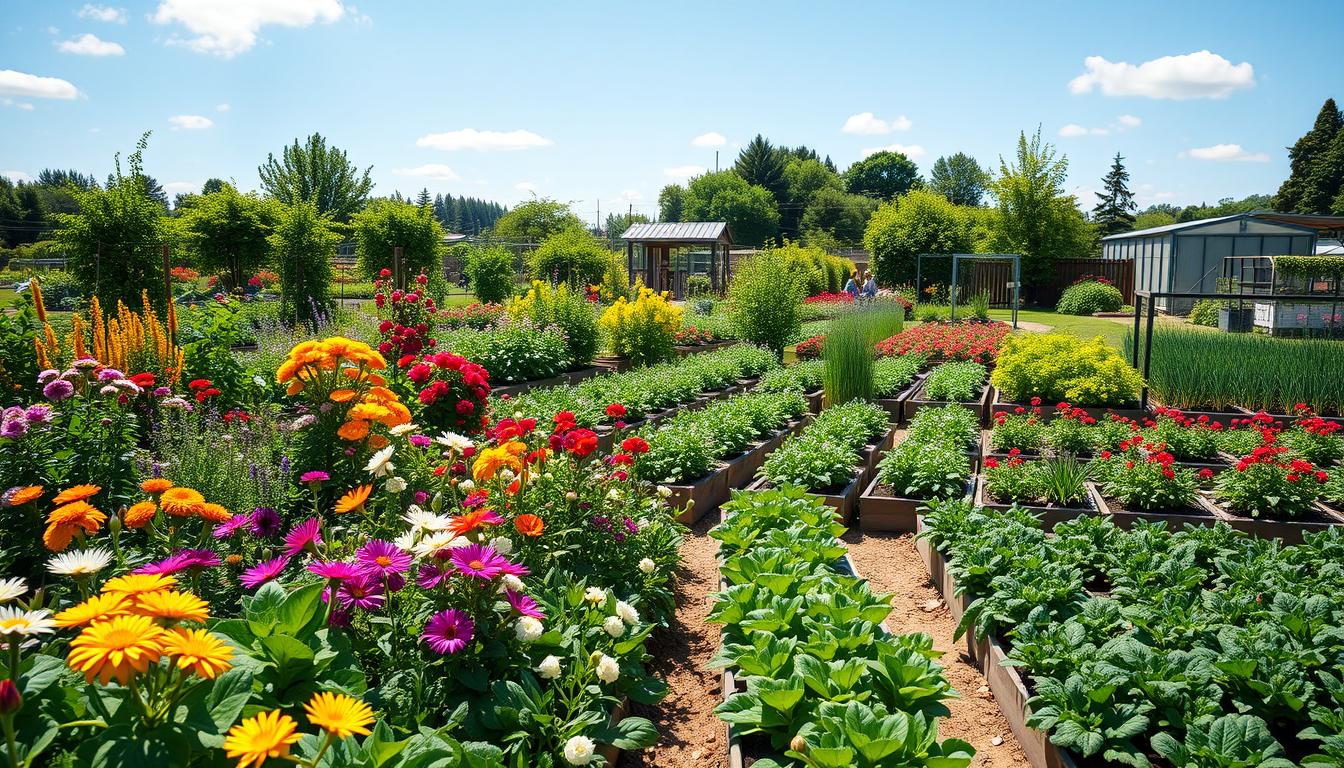I’m excited to share my experience with seasonal gardening. It has helped me achieve a vibrant and thriving garden all year. By following a well-planned gardening calendar, I’ve made the most of each season. This way, I enjoy a bountiful harvest.
I’ve learned the importance of understanding each season’s unique characteristics. This knowledge helps me adapt my gardening techniques. By doing this, I’ve created a beautiful and productive garden. It brings me joy and fresh produce all year.
In the following sections, I’ll share my expertise. I’ll give you the tools and knowledge to create your own thriving seasonal garden. You’ll learn effective gardening tips and how to use a well-organized gardening calendar.
Understanding Seasonal Gardening Basics
As a gardener, I’ve learned that knowing the basics of seasonal gardening is key. It’s about picking the right plants for each season. And following a guide to help them grow well.
First, we need to understand the seasons and how they impact plants. For example, in spring, plants need more water and nutrients. In summer, they need sunlight and heat.
What is Seasonal Gardening?
Seasonal gardening means planting and harvesting based on the seasons. It considers the local climate, soil, and weather. This ensures plants grow and yield their best.
Importance of Timing in Gardening
Timing is crucial in gardening. Planting at the right time can greatly impact your garden’s success. For example, planting tomatoes and peppers in summer leads to a big harvest. Planting broccoli and kale in spring or fall results in healthier, tastier crops.
Here are some tips for choosing the best plants for each season:
- Spring: Plant cool-season crops like lettuce, spinach, and peas.
- Summer: Plant warm-season crops like tomatoes, peppers, and cucumbers.
- Fall: Plant cool-season crops like broccoli, kale, and carrots.
- Winter: Plant indoor crops like herbs and microgreens.
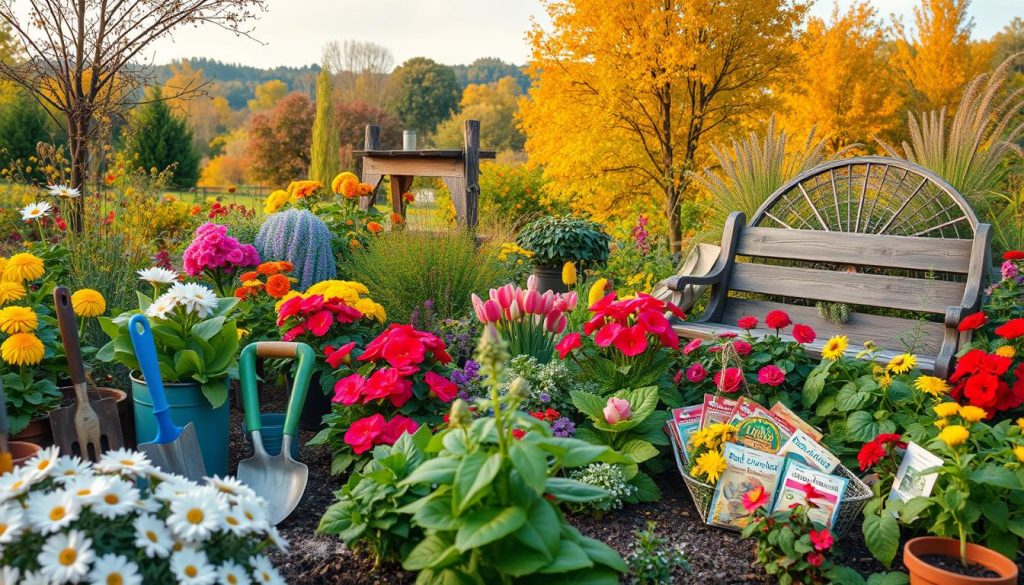
Planning Your Seasonal Garden
When planning my seasonal garden, I focus on a few key things. First, I pick the best spot for my garden. I look at sunlight, soil, and water. This makes sure my plants grow well.
Having a gardening calendar is also crucial. It helps me know when to plant, care for, and harvest my crops. This way, my garden gets the right care at the right time, leading to a great harvest.
Choosing the Right Location
I search for a spot that gets at least six hours of sunlight a day. The soil should drain well and be full of organic matter. Plus, it’s good to have water nearby for easy care.
Creating a Planting Calendar
To make a planting calendar, I research the growing seasons for my crops. Then, I plan out when to plant, fertilize, and harvest. This keeps me organized and ensures my plants get the care they need.
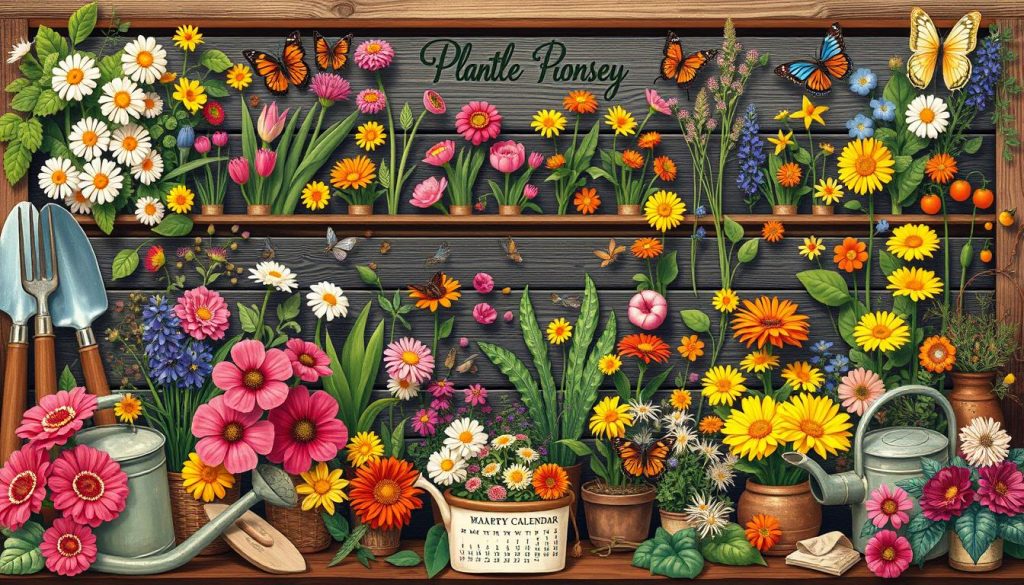
By following these steps and making a good gardening calendar, I can have a successful garden. Whether it’s veggies, fruits, or flowers, a well-planned garden leads to a great harvest and fun gardening.
Spring Gardening: What to Plant
Starting a garden in spring is exciting for beginners. It’s the best time to plant many vegetables and flowers. First, you need to get your soil ready. This means clearing out old stuff, adding nutrients, and making the soil smooth for planting.
Some great veggies for spring are lettuce, spinach, and radishes. They grow well in cool weather. For a colorful garden, try planting tulips, daffodils, and hyacinths. These flowers are not just pretty; they also attract bees and butterflies.
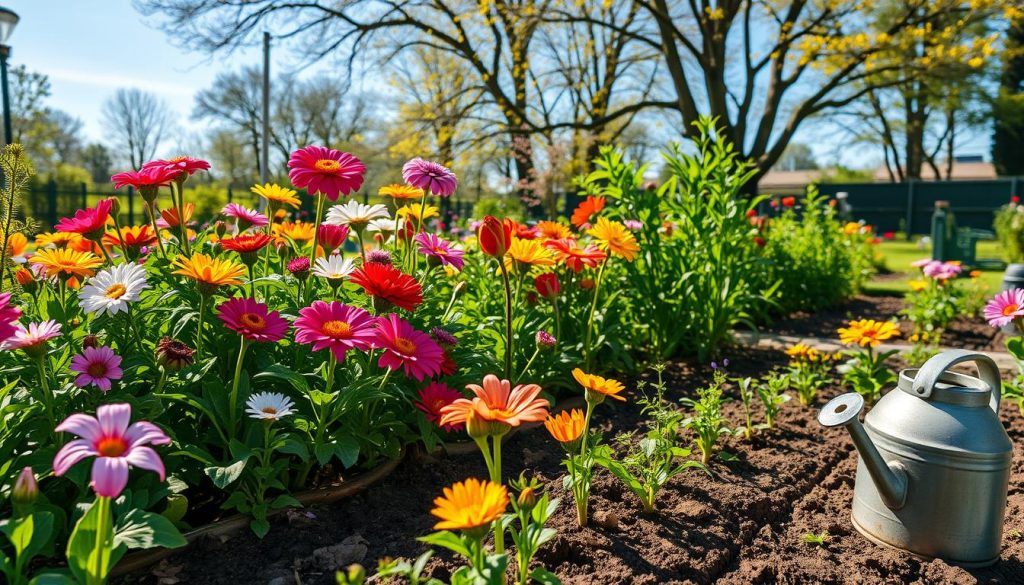
- Start seeds indoors 4-6 weeks before the last frost date to get a head start on the growing season
- Use compost or well-rotted manure to enrich the soil and improve its structure
- Water plants regularly, but avoid overwatering, which can lead to disease and root rot
By following these tips, you can make your garden beautiful and healthy. Spring is a great time to start gardening, whether you’re new or have experience. Get outside and start planting!
| Vegetable | Planting Time | Harvest Time |
|---|---|---|
| Lettuce | Early spring | 40-50 days |
| Spinach | Early spring | 30-40 days |
| Radishes | Early spring | 20-30 days |
Summer Gardening: Keeping Your Plants Thriving
As summer gets closer, it’s key to change your gardening ways. This ensures your plants stay healthy. With the right tips and a seasonal guide, you’ll have a great harvest and beautiful flowers all summer.
Best Practices for Watering
Watering right is vital in summer. Too much water can harm your plants, while too little stresses them. Here are some tips to remember:
- Water your plants deeply but not too often to help roots grow deep
- Try not to get water on the leaves to avoid diseases
- Use drip irrigation or soaker hoses to water the roots directly
Mulching for Moisture Retention
Mulching keeps the soil moist and stops weeds. It also keeps the soil cool and prevents erosion. Here are some good mulching choices:
- Organic mulch like wood chips or bark
- Inorganic mulch like plastic or landscape fabric
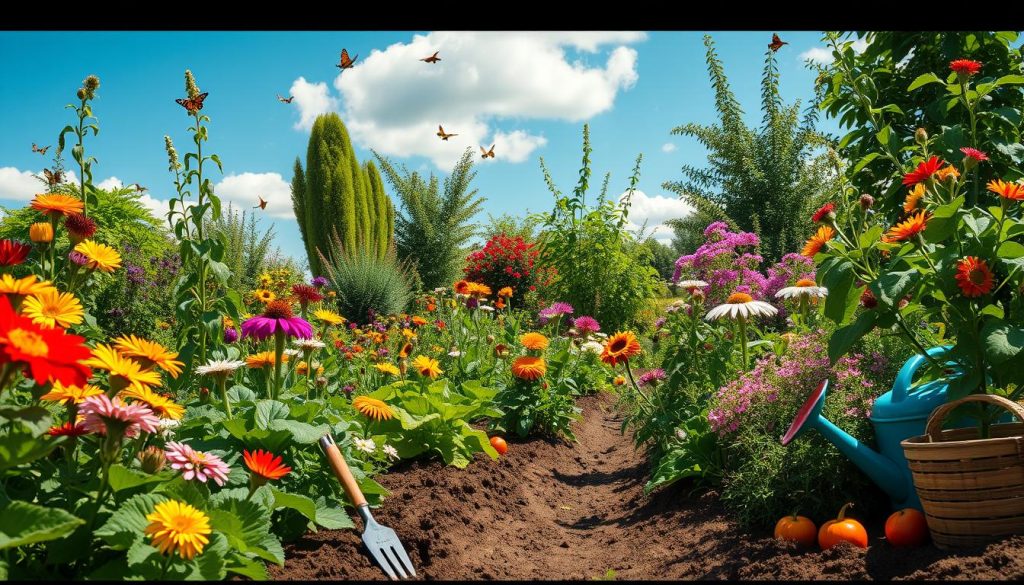
Pest Control Strategies
Summer is when pests and diseases can grow. Watch for pests like aphids, whiteflies, and spider mites. Use natural or chemical controls as needed. A good seasonal guide helps with pest control and gardening tasks.
Fall Gardening: Preparing for Winter
As the seasons change, it’s key to get your garden ready for winter. This means picking the right time to harvest your veggies and storing them for later. Knowing the best plants for each season is crucial for a thriving garden. For example, fall is great for planting cool-season crops like broccoli and kale.
To get a good harvest, it’s important to know when to pick each vegetable. Here are some tips to remember:
- Check the seed package or research the specific variety of vegetable you’re growing to determine the average days to maturity.
- Keep an eye on the weather forecast, as extreme temperatures or frost can damage your crops.
- Harvest your vegetables in the morning, when the plants are at their highest water content.
After harvesting, it’s time to get the soil ready for next season. Add organic matter like compost or manure to improve soil structure and fertility. By following these steps and choosing the right plants for each season, you’ll have a thriving and sustainable garden.
Soil Preparation for Next Season
Soil preparation is vital for a healthy and productive garden. By understanding the best practices for soil preparation, you can create an ideal environment for your plants. Whether you’re a seasoned gardener or just starting, these tips will help you enjoy a bountiful harvest and the rewards of vegetable gardening by season.
Winter Gardening: Indoor Options
When winter comes, many think gardening stops. But, you can keep gardening all year with a bit of creativity. Bringing your garden inside is a great way to do this.
Indoor herbs let you add fresh flavors to your meals, even in winter. You’ll need the right conditions for your plants, like temperature, humidity, and light. A gardening calendar helps you know when to plant, water, and harvest.
Tips for Growing Herbs Indoors
- Choose herbs that thrive in indoor conditions, such as basil, mint, and parsley
- Provide plenty of light, either from a sunny window or using grow lights
- Water carefully, as indoor plants can be prone to overwatering
Using grow lights is key for indoor gardening. They give your plants the right light to grow well. A good grow light can make a big difference in your indoor garden.
Using Grow Lights Effectively
Follow these tips to enjoy fresh herbs all year. Indoor gardening is perfect for any gardener, keeping your green thumb active in winter.
Seasonal Gardening Challenges I Overcame
As a seasonal gardener, I’ve faced many challenges. Weather, pests, and diseases were just a few. But with the right tips and experience, I’ve overcome them and found success.
Adapting to Unpredictable Weather
Weather was a big challenge for me. I started checking the forecast often and planned my gardening. I also had a greenhouse and indoor space for bad weather.
Dealing with Pests and Diseases
Dealing with pests and diseases was tough. I used organic methods like neem oil and diatomaceous earth. I also washed my hands and tools often. Monitoring my plants helped me catch problems early.
Here are some tips for pests and diseases:
- Use companion planting to keep pests away
- Rotate crops to avoid soil diseases
- Use row covers to block pests
By following these tips, beginners can succeed and enjoy a great harvest. Always keep learning and don’t hesitate to ask for help.
| Gardening Challenge | Solution |
|---|---|
| Unpredictable weather | Check weather forecast, have backup plan |
| Pests and diseases | Use organic pest control, practice good hygiene |
Tools and Supplies for Seasonal Gardening
To succeed in seasonal gardening, you need the right tools and supplies. As a seasoned gardener, I’ve found that a good toolkit is key. Here, I’ll share what you need to start your seasonal gardening journey.
A gardening calendar helps you stay organized. It keeps your garden ready for each season. You’ll need gloves, pruning shears, and a watering can to get started.
Essential Gardening Tools
- Gloves: to protect your hands from thorns and dirt
- Pruning shears: to trim and shape your plants
- Watering can: to provide your plants with the right amount of water
Recommended Soil Amendments and Fertilizers
Soil amendments and fertilizers keep your soil healthy. Use compost, manure, and organic fertilizers. They help your garden grow strong and sustainable.
With these tips and tools, you can create a beautiful garden. Always check your gardening calendar to stay on track and adjust as needed.
| Tool | Description |
|---|---|
| Gloves | Protect your hands from thorns and dirt |
| Pruning shears | Trim and shape your plants |
| Watering can | Provide your plants with the right amount of water |
Sustainability in Seasonal Gardening
As I explore seasonal gardening, I’ve learned how crucial sustainability is. It’s about cutting down waste and making a cycle. This is done through composting, which turns organic stuff into rich soil.
Composting is a simple way to cut down waste and garden sustainably. Adding compost to the soil makes it better for plants. It holds water and gives plants the nutrients they need. To compost well, mix “green” and “brown” stuff like food scraps and leaves. Keep it moist.
Composting and Its Benefits
Composting has many perks, like less waste in landfills and a natural fertilizer. Benefits include:
- Soil gets better and more fertile
- Plants grow better and stay healthy
- You need less chemical stuff for plants
- It’s good for the planet and cuts down on carbon
Native Plants for Low Maintenance
Using native plants is also key for sustainable gardening. These plants fit the local weather and soil. They fight off pests and need less water and care. Some great native plants for gardening include:
By using compost and native plants, my garden gets better and needs less work. These tips help reduce waste, save resources, and support life in my garden. It becomes a healthy, thriving place.
| Native Plant | Benefits |
|---|---|
| Butterfly Bush | Attracts pollinators, low maintenance |
| Black-eyed Susan | Drought tolerant, attracts birds and butterflies |
| Blazing Star | Low maintenance, attracts pollinators and hummingbirds |
My Favorite Seasonal Gardening Tips
As a seasoned gardener, I’ve found that a good seasonal gardening guide is crucial. For beginners, starting with the basics is key. One great tip is to rotate crops regularly. This improves soil health and reduces pests and diseases.
This method is great for a seasonal gardening guide. It helps you plan for each season. By rotating crops, your soil stays fertile and balanced, which is vital for plant growth. It also breaks disease and pest cycles, cutting down on the need for harmful chemicals.
Remembering to Rotate Crops
To rotate crops well, divide your garden into sections. Assign a crop family to each section. Then, switch these families each season to avoid nutrient depletion. For example, if you grew tomatoes last season, try legumes or brassicas this season.
Companion Planting Strategies
Companion planting is another valuable technique. It involves planting different crops together to boost growth, flavor, and pest resistance. For instance, marigolds with tomatoes deter nematodes, and basil with lettuce enhances flavor. These strategies are great for beginners and will help your garden thrive.
By using these tips in your seasonal gardening guide, you’ll create a balanced garden. It will produce fresh, healthy produce all year. Whether you’re experienced or just starting, these techniques will help you enjoy a successful harvest and the joys of seasonal gardening.
Community and Seasonal Gardening
As I explore seasonal gardening, I’ve learned how crucial community is. Connecting with other gardeners has given me a lot of knowledge and chances to grow. Joining local gardening clubs has been key. I’ve learned from experts and shared my own stories.
This community support has been invaluable. It helps me stay on track with my gardening tasks. It’s also helped me tackle seasonal gardening challenges.
Being part of a local gardening club has its perks. It lets me help out in community garden projects. These projects are great for sharing knowledge and skills. They also help us create beautiful gardens that benefit everyone.
- Volunteering at a local community garden
- Participating in gardening workshops and classes
- Joining online forums and social media groups for gardeners
By taking these steps, you can join a vibrant and supportive gardening community. Remember, gardening is not just about plants. It’s also about the people and relationships that make it special.
Conclusion: Embracing the Seasonal Gardening Journey
Reflecting on my gardening journey, I feel a deep appreciation for the joys and challenges of seasonal gardening. It has taught me patience, adaptability, and a connection to nature. Each season brings its own delights, from spring’s vibrant blooms to summer and fall’s harvests.
I’ve learned to embrace the changes in gardening tips and find joy in small victories. Seeing a seedling grow or enjoying fresh homegrown produce is priceless.
I encourage you to start your own seasonal gardening journey. Cultivate a love for nature and share your experiences. Together, we can grow a community of passionate gardeners, each with their own story.

